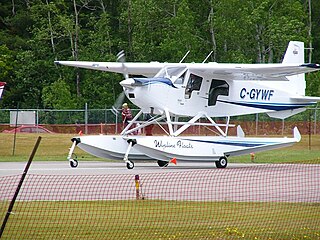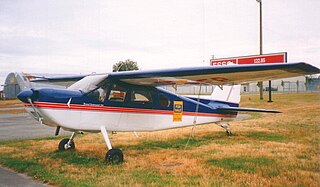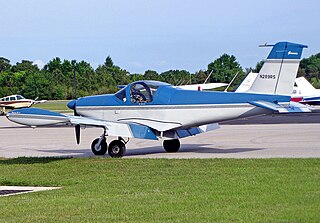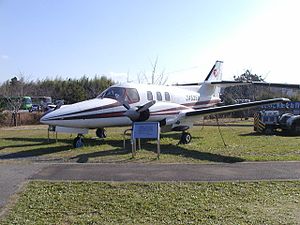
The IMCO CallAir A-9 is an agricultural aircraft that first flew in 1962, a development of the company's previous successful crop-dusters. It is typical of aircraft of its type - a single-seat aircraft with a low wing incorporating spraying gear.

The Cessna T303 Crusader is an American six-place light twin-engined aircraft built by Cessna Aircraft Company. Production ceased in 1986.

The Cessna 414 is an American light, pressurized, twin-engine transport aircraft built by Cessna. It first flew in 1968 and an improved variant was introduced from 1978 as the 414A Chancellor.

The Cessna 340 is a twin piston engine pressurized business aircraft that was manufactured by Cessna.

The Partenavia P.64B/P.66B Oscar is an Italian two/four-seat, single-engined, high-wing monoplane built by Partenavia.

The Piper PA-36 Pawnee Brave is a 1970s American single-engined, low-wing, propeller-driven agricultural plane built by Piper Aircraft.

The Cerva CE.43 Guépard is a 1970s French four/five seat cabin monoplane produced by Cerva.

The Found FBA-2 is a 1960s Canadian four/five-seat cabin monoplane that was produced by Found Aircraft.

The Found Centennial 100 is a Canadian six-seat cabin monoplane produced by Found Brothers Aviation.

The Oberlerchner JOB 15 was an Austrian two-seat light aircraft produced by Josef Oberlerchner Holzindustrie, which had previously designed and built gliders.

The Call-Air Model A is an American two- to three-seat utility aircraft designed by the Call brothers and built by the Call Aircraft Company, later developed into a successful line of agricultural aircraft.

The Mudry CAP 20 is a French family of aerobatic competition single seater monoplanes.

The DINFIA IA 45 Querandi was a 1950s Argentine twin-engined light transport aircraft built by the DINFIA.

The Evangel 4500 was a 1960s American twin-engined light passenger/cargo monoplane built by the Evangel Aircraft Corporation.

The Hindustan Aeronautics HA-31 Basant is a 1970s Indian agricultural monoplane built by Hindustan Aeronautics.

The Piper Aerostar is an American twin-engined propeller-driven executive or light transport aircraft, designed by Ted R. Smith. It was originally built by Ted Smith Aircraft Company, but the design was acquired in 1978 by the Piper Aircraft Corporation, which continued production of the aircraft as the PA-60.

The Pazmany PL-1 Laminar and Pazmany PL-2 are American two-seat trainer and personal light aircraft designed by Ladislao Pazmany to be marketed as a homebuilt aircraft by his company Pazmany Aircraft Corporation. The aircraft was built under license in Taiwan as the AIDC PL-1B Cheinshou. It was later followed by an improved version the PL-2. The SLAF Aircraft Engineering Wing developed a modified variant of the PL-2 in 1977, which was never used operationally.

The SIAI-Marchetti S.210 was a 1970s Italian twin-engined cabin-monoplane designed and built by SIAI-Marchetti as a development of the single-engined SIAI-Marchetti S.205.
The Eshelman FW-5 was a 1940s American experimental cabin monoplane designed and built at Dundalk, Maryland by the Cheston L. Eshelman Company.
The FLUGWAG Bremen ESS 641 was a 1970s German glider-towing monoplane designed and built by the Flugwissenschaftliche Arbeitsgemeinschaft Bremen research organisation.


















